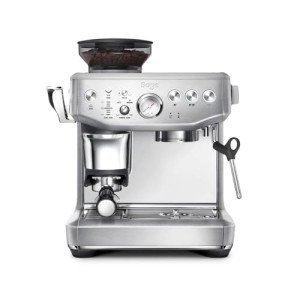Heat Exchange Espresso Machines: A Comprehensive Guide
Espresso machines have actually evolved substantially for many years, catering to the requirements of home baristas and coffee experts alike. Amongst Portable Espresso Machines , heat exchange espresso machines have actually gained popularity due to their ability to provide consistent performance and remarkable brew quality. In Compact Espresso Machines , we will explore the operations, benefits, and important functions of heat exchange espresso machines, providing an extensive understanding for both prospective purchasers and coffee lovers.
Understanding Heat Exchange Technology
Heat exchange espresso machines operate on a distinct principle that permits simultaneous water heating for developing and steaming. They are geared up with a single boiler that makes use of a heat exchanger system. This function is substantial as it makes it possible for users to brew espresso while steaming milk simultaneously, promoting effectiveness in the coffee-making procedure.
How Does a Heat Exchange Espresso Machine Work?
The process starts with the machine's water inlet filling the boiler. As the water warms up, it turns to steam. The innovative heat exchanger uses hot steam to heat additional water in a different passage developed specifically for the brew group. This indicates that water can reach the ideal developing temperature level without awaiting the boiler to change. The key steps include:
- Water Fill: Water is drawn into the boiler.
- Heating Process: The boiler warms up as water is converted into steam.
- Heat Exchange: Steam heats up water in the heat exchanger tube.
- Developing: Water from the heat exchanger is pressed through coffee premises, extracting the tastes required for a rich espresso.
This procedure enables fast temperature level adjustments and enhanced coffee extraction.
Advantages of Heat Exchange Espresso Machines
Heat exchange espresso machines offer a number of benefits, especially for those looking to optimize their coffee experience. Here are some key advantages:
- Simultaneous Brewing and Steaming: Users can brew espresso while steaming milk, making it ideal for hectic cafes and home baristas who value performance.
- Temperature level Stability: The boiler's steam pressure assists maintain a steady temperature level, which is vital for constant espresso extraction.
- Versatility: The design allows for quick switching between brewing and steaming, making it simpler to create different coffee beverages, from lattes to coffees.
- User-friendly: Models often come with accessible controls, making it practical for both beginners and skilled baristas to produce quality beverages.
- Professional Quality: Heat exchange machines are typically utilized in commercial settings, providing users with high-quality brewing efficiency in the house.
Key Features to Look for in Heat Exchange Espresso Machines
When thinking about the purchase of a heat exchange espresso machine, there are numerous features that one need to take into account:
- Build Quality: Look for machines made from durable materials, such as stainless-steel or brass, guaranteeing durability.
- Boiler Size: A larger boiler will hold more water and sustain higher output over time.
- PID Temperature Control: This function assists keep consistent brew temperatures, which can boost the coffee-making procedure.
- Group Head Design: Machines with a saturated or semi-saturated group head provide much better temperature level stability.
- Alleviate of Use: User-friendly user interfaces and user-friendly controls enhance the overall experience for baristas at all ability levels.
- Steam Wand Quality: A good steam wand with appropriate insulation and flexibility enables better texturing of milk.
- Water Reservoir Size: Depending on your requirements, consider how frequently you wish to fill up the water tank.
Comparison of Popular Heat Exchange Espresso Machines
To better comprehend the choices available in the market, below is a contrast table of some popular heat exchange espresso machines:
| Machine Model | Boiler Size | PID Control | Rate Range | User Ratings |
|---|---|---|---|---|
| Profitec Pro 700 | 2.0 L | Yes | ₤ 2,000-₤ 2,500 | 9.5/ 10 |
| Rocket Espresso R58 | 1.8 L | Yes | ₤ 2,400-₤ 2,800 | 9.4/ 10 |
| Elekta Bianca | 1.8 L | Yes | ₤ 2,500-₤ 3,000 | 9.6/ 10 |
| La Spaziale S1 Vivaldi II | 1.5 L | Yes | ₤ 1,800-₤ 2,200 | 9.2/ 10 |
| Bezzera Magica | 1.2 L | No | ₤ 1,600-₤ 1,800 | 9.0/ 10 |
FAQs About Heat Exchange Espresso Machines
What is the primary distinction between a heat exchange and a dual boiler espresso machine?
While both types can brew espresso and steam milk at the very same time, dual boiler machines have different boilers for developing and steaming. In contrast, heat exchange machines use a single boiler and a heat exchanger to accomplish the very same function.
Are heat exchange machines ideal for beginners?
Yes! Lots of heat exchange machines are designed with user-friendly features, making them available for beginners. With appropriate assistance and practice, users can quickly produce quality espresso.
What type of upkeep do heat exchange espresso machines require?
Regular upkeep consists of descaling, cleaning up the boiler, inspecting seals and gaskets, and keeping the group head clean. Regular upkeep ensures durability and consistent performance.
Can I use a heat exchange machine for different kinds of coffee drinks?
Absolutely! Heat exchange machines enable users to create a range of coffee beverages, including espresso, lattes, cappuccinos, and more.
Heat exchange espresso machines represent a blend of development and custom, offering coffee lovers with the tools needed for crafting the perfect cup. Their ability to all at once brew and steam, combined with accurate temperature control, makes them an engaging option for both home baristas and professionals. With the ideal understanding on functions and maintenance, users can open a world of elegant coffee experiences, making sure that each sip is as delightful as the last.

